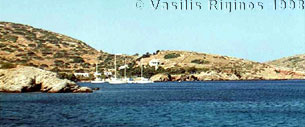This web page contains the logs of a week-long solo trip with S/Y Thetis in the Greek Aegean from the island of Samos, to Arki, Levitha, Astypalea, Lipsi, Agathonisi, and back to Samos. The logs are illustrated with maps and photographs, and also include some historical and geographical descriptions of the places visited as well as several links to other related web sites.
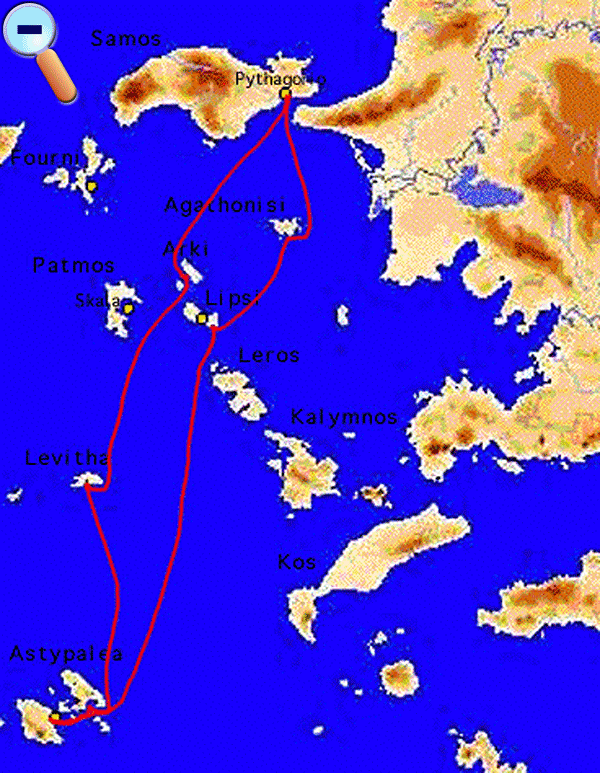
Sunday August 2, 1998 Day 1
After a few days rest in Kalami, I am getting back to Thetis. This time I am singlehandling again but now I will go to new places, not just to familiar islands near Samos. I departed from Pythagorio, heading to Arki at 1055. Near Samos the wind was a light 5-10 knots coming from the ENE and we were motoring, but just like last time on this route, once we cleared Samiopoula the wind changed direction to WNW and increased to 10-25 knots, and we were able to sail with both the main without reefs and the full genoa. As we got further from the land, the wind increased and I reduced the genoa to avoid loading the autopilot. It was a very pleasant fast sail. The Navtex forecast called for 5-6 NW for both the Samos Sea and the Sea of Ikaria. No significant change was expected for tomorrow. My plan was to stop overnight at Arki and then sail tomorrow to Levitha.
We arrived at Arki at 1500 having sailed 22.4 M. I anchored without any problems at my favorite cove (2nd S of Port Augusta) also known as Porto Grosso or Glipapas [37° 22.4' N 26° 44.4' E]. The sea was flat. I snorkeled and checked the anchor, launched the zodiac, and washed Thetis from the dust she had collected in Pythagorio. There was plenty of fresh water as I had topped the tanks before departure. I put up the tent using the new pole that my friend Thanasis Papageorgiou procured for me in Samos. It is a great improvement from the painter’s pole I bought in Patmos.
By 7:30, I had my hot shower and I was sitting at the cockpit enjoying this almost perfect anchorage. The temperature was a comfortable 30° C (86° F) moderated by a pleasant breeze of 10-15 knots. The sea was flat, the sheep’s bells were the only sound. No cars. Thetis was the only boat here. I sipped an ouzo watching the sun go down. I was in Paradise! I guess I had missed being on Thetis. It is a hard life, having to share myself between Thetis and Kalami. Magnificent sunsets in Kalami versus the solitude and tranquillity of a cove. Green versus blue. A fishing boat went “putt-putt” at a distance, trolling a fishing line. This was the only man made sound I have heard for the past two hours. The sounds of bells were now louder as the sheep were all going to their watering place as the sun was setting.
Later I cooked dinner: turkey cutlets with spaghetti and fresh tomatoes from Kalami. I then set the paraffin lamp as an anchoring light. This is working very well and it conserves electricity, while using a most meager amount of paraffin. While going to the bow to hang the lamp, I stepped on the zodiac oar, which I had rather foolishly left on the deck. The oar fell overboard and started drifting away. It took me some time to get the outboard on the zodiac, before I could go after the oar. By that time I could not see it. I took a large flashlight and searched for quite some time, but it was in vain. The oar was gone! I went to bed furious at myself for making such a stupid mistake.
Monday August 3, 1998 Day 2
After puttering around the boat preparing for the sail, I raised and lashed down the zodiac. I then snorkeled in a vain attempt to find the missing oar in case it had sunk. I raised the anchor at 0925 and left the cove heading towards Levitha. There was a light NW wind of 10-15 knots and we were able to sail at a broad reach for about 2 hours. Then, the wind died out and I had to motor for about ½ hour while eating a lunch of τουρλού (tourlou - a Samian dish made of baked eggplants, zucchini, potatoes, tomatoes, onions, garlic, and parsley), a good quantity of which I had brought with me from Kalami. The Navtex had forecasted for this area force 6 winds locally 7, there was no 7 here! But after lunch the wind increased somewhat, allowing me to turn off the engine. The Navtex had also given a warning of staying away from the cable-laying ship Teneos and gave the coordinates where she would be operating. They were wrong! We came to within 1.2 miles of her. She was almost ½ a degree (30 M) off from where the warning said.
The wind increased some more to 15-20 knots W which allowed a comfortable sail to Cape Spano, the easternmost point of Levitha. After rounding the cape, the wind increased further to 25-30 knots and it was a hard beat to the entrance of the bay. I went to the East cove [37° 0.14' N 26° 28.06' E] because Heikell describes it as the “best anchorage” on the island. We arrived at 1505, distance from Arki 22.9 M.
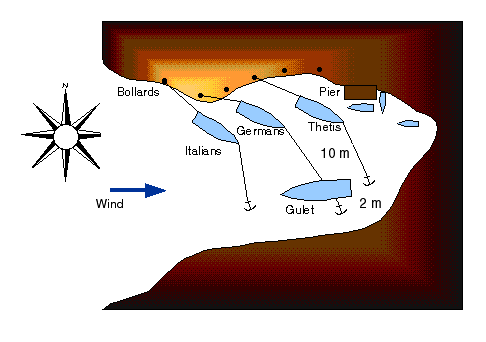
The situation there was not very good. There were a number of fishing boats by the tiny pier. An Italian sailboat had just arrived a few minutes before Thetis and was maneuvering in the narrow inlet to anchor and take a shore line to one of the bollards. There was not enough room for two boats to maneuver, so I had to wait for the Italians. In the mean time, a chartered sailboat full of Germans arrived, and was also standing by. After, the Italians moored, I dropped the anchor but it did not hold. I raised it. It was fouled with very large plastic bags! I re-anchored, again the anchor did not hold (Heikell says “good holding”). After the third attempt, it seemed to hold. I launched the zodiac and took a long line (over 100 m) to a bollard, because Thetis was drifting quickly away blown by the W wind. The Germans were getting very impatient with my slow progress. I took the line back on Thetis and started warping towards the bollard. It was slow going because the wind was now coming with strong gusts and there was a considerable chop. Thetis was drifting uncomfortably close to one of the fishing boats which were docked sideways to the little pier. The Italian gentleman came with his inflatable to help. He pushed Thetis’ stern toward the wind, which allowed me to take the slack of the line and warp some more and away from the fishing boat. An hour or so later, as I was almost done, the anchor dragged. By this time the Germans had moored, and a large Gulet with a Turkish and an Austrian flag had also arrived and was hovering dangerously close. I was very unhappy, tired, and in danger of colliding with the fishing caïque. One of the fishermen suggested that I try my luck anchoring off-shore in a near-by cove. While he fended Thetis away from his boat, a young man untied my line, and I, once again, raised the anchor. The anchor came up totally fouled with fishing nets and more plastic bags. With the anchor on-board I put the engine forward and left this most uncomfortable inlet. Phew!
The suggested cove was less than ½ mile away, west of the inlet. It was sheltered from the wind and the water was indeed calm and flat, no chop. It was however, also very narrow. After I anchored [37° 0.17' N 26° 27.78' E], I took a breathing break and, since the anchor was holding, I made myself a cup of coffee. Rested somewhat, I snorkeled to check the anchor. I was not pleased! The anchor was held by sea weeds. This is always a dangerous situation because with a strong gust the weeds can be up-rooted and then the anchor will drag. I re-anchored for one more time. This time I went deep into the cove because I decided not to rely on the single anchor alone. I then took a shore line, 80 m long, and tied it to a rock. I tied the other end to the bow, thus having the equivalent of two anchors, the one on the windward side not capable of dragging. I checked the first anchor with the mask and it was, this time, well dug-in. From our arrival to the time that I felt secure, almost 3 hours had elapsed. I was exhausted!
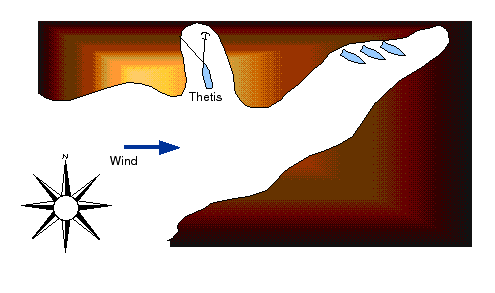
Levitha (Λέβιθα) or Levithia (Λεβίθια) is a small low lying island with 4 (yes, four) inhabitants. Its nearest neighbor, Kinaros, is uninhabited. During the summer months both islands are frequented by fishing boats and sailing yachts that take advantage of their protected coves.
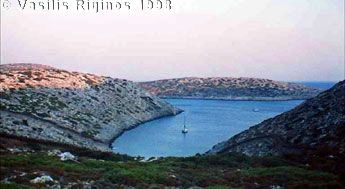
After resting for a while, I took a hot shower and went ashore. I walked up the hill to the little hamlet where they run a small restaurant during the summer months. The restaurant was in a vine-covered yard with flag-stones and a fireplace grill. There were about 5 tables, and everything was spotless. They had very fresh σαργοί (sargi - broad silver fish with black tail). I ordered a couple but since it was still daylight, I took a long walk. Back in the hamlet I met all 4 of the island inhabitants, all members of the Kamposos family (Demetris, Irene and their late teenage sons Tasos and Manolis). They cooked the fish on the charcoal grill to perfection. I ate them with great gusto accompanied with wine and a salad. The father of the family complained to me that although there are a few yachts here almost every day, not many crews actually come to eat at his restaurant. He also said that most fish served at the restaurants in Patmos and Samos are not locally caught, but imported from as far as Brazil! Who knows?
Back on Thetis I had a fruit and watched the stars and the moon. It was a very tiring day that ended well. I was particularly happy that my heart did not give out. I suppose that the old pump was subjected today to a very thorough stress test.
Tuesday August 4, 1998 Day 3
I was planning to take a long walk on the island but I was still tired, despite a good night’s sleep. Instead, I covered the sails, put up the tent and took it easy reading in the cockpit. After some time, I attacked the problem of the watermaker. Its output had slowly degraded to a mere trickle of fresh water. After I cleaned it in Patmos, instead of improving it deteriorated even further to the point of almost no output. Now I took it apart, save for the salinity sensor which I can bypass. I checked and cleaned the solenoid and all the tubes. I changed its paper pre-filter which was indeed dirty and re-primed it. Now it worked but still its output was low. I suspected that its sea-water intake may be clogged by the barnacles which we acquired in Pythagorio, and after I dove to clean them the output improved a little more, but not by much. I ran the motor and re-charged the batteries.
I took a ride with the zodiac to explore the two east and west coves which are the recommended anchorages by both Heikell and the Greek Portolanos. The west cove is much more attractive than the polluted east cove. But on this very gusty day with strong WNW wind, Thetis’ cove is by far the more protected anchorage. The only problem is that it is so narrow that only one boat really fits. The water in this cove is very clean and clear. The state of the east cove is a real scandal for such a remote place. The fishermen, it seems, use it as their garbage dump.
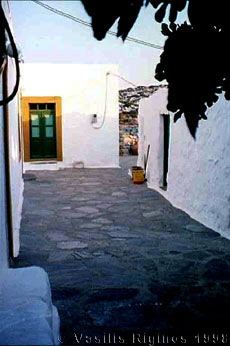
In the afternoon, after some more rest, I did some further troubleshooting. This time I attacked the SeaTalk data bus problem. While in Samos, I had called the Autohelm dealer in Greece, Mr. Skordilis, and described the symptoms to Dinos, the technician. Dinos thought right away that the radar was defective and he asked me to send it back to Athens. I was not too convinced that there was anything wrong with the radar so I did not send it. Now I started by replacing the autopilot control unit, since I had a spare (last year the controller had failed and I had bought a new one, Autohelm in the US replaced the failed unit free of charge, so now I have two controllers). After replacing the autopilot controller, everything, including the track mode, started working again. The radar now gets SeaTalk data from all the other instruments, and so does the SeaTalk/NMEA bridge which activates the new alarm buzzer. The only problem left is that the bridge needs to have the autopilot ON to provide its power. The Navtex forecast is for force 6 for today with the wind attenuating tomorrow. I decided to leave tomorrow morning for Astypalea.
In the evening I went for a long walk. I climbed to the top of the island and saw an abandoned World War II Italian outpost. It is a nice, dry island with many goats, sheep and even cows. They all belong to the Kamposos family. The dry rock fences (ξερολιθιά - xerolithia) are everywhere and in very good repair. I walked to the hamlet. The hamlet and the restaurant are also in very good shape. Clean, neat, and freshly white washed. I felt very low in energy, very dehydrated, and too lazy to cook, so I ate at the restaurant again. I had a delicious steak with beer. Since I would not eat the usual fried potatoes, they brought me, without me asking, some pasta that they had made for themselves. Unlike last night, tonight there were customers: a large Italian group, and a smaller German group. None of them were particularly friendly.
Wednesday August 5, 1998 Day 4
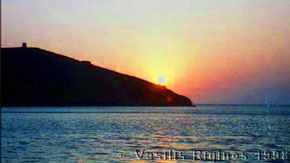
I got up at 5:00 and started preparation for departure to Astypalea. The sunrise across the bay was spectacular. I picked up the boat, untied the long shore line (cavos), raised and lashed the zodiac, and raised the anchor.
The first thing that was wrong was the knot meter which did not work. This most likely was caused by the sensor being fouled by barnacles collected in Pythagorio. As it was too early and too cold for a dive, I stopped the boat and, while she was drifting I removed the sensor from the through-hull. This was a messy job, because no matter how quickly the sensor is removed and the hole capped, plenty of water gushes into the bilge. After cleaning the barnacles from the sensor the messy process was repeated. Then, the bilge had to be pumped and the cabin floor wiped. After that the knot meter worked again. The next problem was that since I had replaced the autopilot’s controller, it had to be re-calibrated. The procedure is to make, very slowly, at least 3 complete 360° turns which allow the controller to compensate for the magnetic deviations caused by the various magnetic fields, ever present in the boat. Once that is done, the boat has to maintain a slow straight course and the reading of the controller display, originating from the flux-gate compass, has to be adjusted so that it matches the reading of the magnetic compass. This removes the bias error.
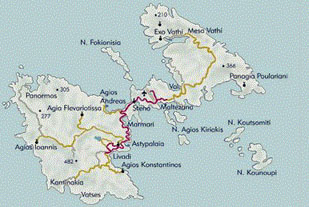
By the time all these tasks were completed and we were truly under way it was 0705. Everything, I mean everything but the wind generator, was working! We were even operating the autopilot in the track mode for the first time this year! (The track mode is the mode in which the autopilot receives the heading and the cross-track error from the GPS, that is once you have set the GPS to go to a waypoint, the autopilot takes you there automatically in the most efficient way, compensating for any drift and leeway).
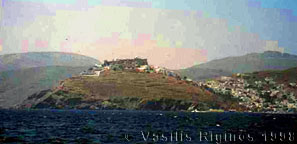
The wind was from the N, at 15-20 knots, directly at our stern. I raised the main, without any reefs, and strung a preventer line as an insurance against any unwanted jibes. We motor-sailed under this configuration for a while and charged the batteries. The wind changed direction, coming from the WNW, and we could sail for a while. Then it changed again. This went on 3 or 4 times until we reached Cape Exopetro (the most southeastern cape in Astypalea also know as Cape Poulari, depending on which chart you are using). At that time the wind picked up to 25 knots N with higher gusts and we were able to sail very fast on a reach. The sea was flat! This state of bliss lasted until we reached the Agrilithi cove where I was planing to spend the day. The violent gusts and the considerable amount of surf, coupled with an ugly factory and a large rusted crane made the cove less than attractive. Having already gathered the sails, we motored to Skala, the main harbor on Astypalea.
We arrived at Skala [36° 32.9' N 26° 21.4' E] at 1335 having covered 33.5 M. I anchored arodo (off-shore) without any problem, despite the very strong gusts. I am very fond of harbors where one can stay arodo rather then dock. This is because while taking advantage of the protection that the harbor provides, one still have privacy and quietness. For the singlehandler, of course, anchoring arodo is much easier than docking. It is amazing how much stronger the wind has been on the lee of the island than out at sea. After anchoring, I put up the tent, snorkeled to check the anchor (it was very well dug-in), had a cup of coffee and took my well earned siesta.
Astypalea or Astipalaia or Stampalia is an isolated island with an area of 96.85 km² with about 1600 inhabitants. While it belongs to the Dodecanese group, geographically and historically it is closer associated with the Cyclades. The name comes from a mythological figure, Astypalea who was the daughter of Phoenix and Perimede and the sister of Europa. She had two sons with Poseidon: Ancaeus, king of Samos and an Argonaut, and Eurypylos, king of Kos. The history of Astypalea is long. There are significant archaeological finds in Ancient Astypalea, some of which are exhibited at the Archaeological Museum. The island, which was part of the Byzantine empire, was taken by the Venetians after the fall of Constantinople in 1207 during the 4th crusade. The Venetian family of Quirini owned the island until 1269 when it reverted to the Byzantines. The Quirinis built the large castle that today dominates the harbor. After the fall of Constantinople in 1453, the island became part of the Ottoman empire. In 1921 it was taken over by the Italians, who held it until 1948 when the Dodecanese were united with Greece. Today it is a very attractive and fairly remote island.
Next to Thetis there was the sailboat Boehme with a Greek flag and registered in Salonica. She was occupied by a young couple. The man came over with his inflatable and asked me if I was Greek, then he asked if I had noticed the small chartered sailboat Lindos with a Swedish crew which was spilling oil all over the harbor. He was very exercised and rightly so. We both went and spoke to the Swedes who were very rude. I am sure they would never have spilled oil in Sweden. Just because Greece is very laid back in law enforcement, it does not mean that our visitors should flaunt the laws, especially the anti-pollution laws. We were very tempted to go and find the authorities but the deed was already done and it was in the middle of the hot afternoon with 32°C (89.6° F) under the tent despite a 28 knot breeze. The gusts were fierce.
During the passage this morning, while the SeaTalk problems originally did seem to have been gone, they raised their ugly head again. While the autopilot did maintain the track mode, the wind instruments would not show a true wind direction when under sail (the radar lost instrument readings at the same time). Under power, however, both the wind instrument and the radar worked properly. I reasoned that the SeaTalk bus was overloaded and not getting enough current so I experimented by re-configuring the bus and providing direct GPS power to different instruments. No go! It is very mysterious. By the time I gave up troubleshooting and had a shower, it was past 7:00 PM.
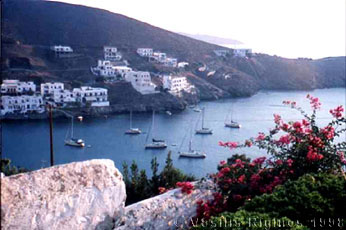
I got into the zodiac intending to go ashore and visit the Quirini castle but as I drove past the Boehme they invited me over for an ouzo. She is owned by Costas Dekides and his French wife Monique. They live in Salonica and for the past 4 years they have spent 6 weeks every summer cruising. They were now on their way to Kastellorizo. They were very interested to hear that I was there last year and wanted all sorts of details. They too prefer the less crowded places, they love Agathonisi and Amorgos, and they also love to hike. It is very nice to meet fellow Greek sailors, it seems that we are an endangered species.
By the time I left the hospitality of Boehme, it was getting too dark for the castle, so I walked for a while around the harbor and then returned to Thetis for dinner. It was a lovely night with the moon almost full.
Thursday August 6, 1998 Day 5
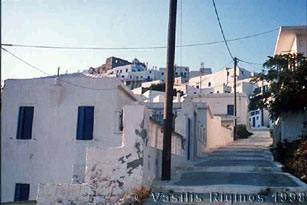
I got up early and by 7:00 I was off the boat climbing the steep road to Chora (the town of Astypalea surrounding the Quirini castle). The town is charming with its white washed buildings and many nooks and crannies. Many of the old buildings are in disrepair and, like in many other Greek islands, are unfortunately not being repaired but are being replaced by concrete monsters. People have become too affluent to want to keep up the old houses. They can afford to replace them with new ones. However, they are not affluent enough to afford anything better than the generic concrete box. What a shame! The damage to traditional architecture is irreversible. An artistically drawn sign advertises the services of a tax preparer. A taste of hell, in paradise.
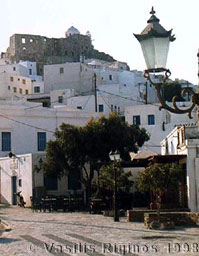
A Street in Astypalea |
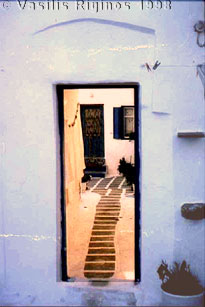
An old house in Astypalea |
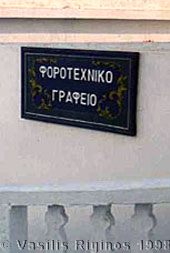
We prepare tax declarations |
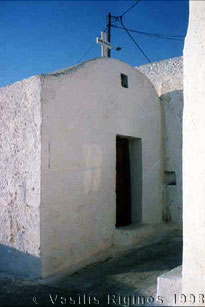
Near the castle is the lovely church of Παναγία Πορταΐτισα (Panagia Portaitisa - Our Lady of the Gate). It has a very nice roof and a well kept garden. The castle itself is in a sad condition. Only two of its churches have been kept, the rest are in ruins. The view is wonderful. I walked through the old ramparts and then down through the town and back to Skala. All together I like Astypalea. It still has many old houses and it is low key enough.
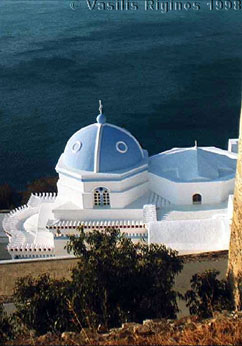
Back on-board, I did some more trouble shooting of the SeaTalk but I could not make sense of my measurements and substitutions. Everything pointed to insufficient current to drive all the interfaces but I did not seem to be able to find a proper connection strategy. The Autohelm manuals were very inadequate and hardly addressed the problem of many interconnected instruments. I gave up.
Some time past noon, I raised the anchor and motored the 1.5 M distance around the castle to the Livadia bay just south of Skala. According to Heikell, Livadia [36° 32.46' N 26° 20.7' E] has fewer gusts than Skala and I was kind of tired of them. It is a very attractive sandy beach, low key, with just a couple of restaurants and a few bathers. About the gusts, I am less sure. It was gusty. There were one or two other boats but a good distance away as the bay is fairly large.
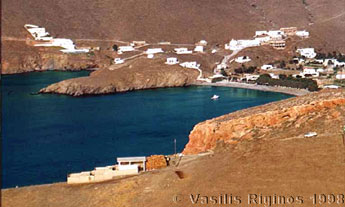
After lunch a took a nap under the tent. I then took the zodiac to a tiny beach under the castle and had a nice swim. The Navtex forecast predicted 5-6 in the Samos Sea for tomorrow, increasing. I decided to head back tomorrow before the next gale catches up with me (I could not stay too long away from Samos because we were doing some work on the house and I had to meet with my daughter, Corinna, who was arriving form the US).
After a shower and an ouzo, I went ashore and walked the 2½ km up the hill to Chora. It took me about 30 minutes, and then another 30 down to Skala. I had dinner of a chicken donner and a beer. As I watched the moon rise, just two days from being full, and its reflection on the water I was tempted to sail tonight and do an all nighter. But I did not have to decide right away. One of the compensations for sailing alone is that you do not have to stick to any pre-declared plan. There is no one to argue if you change your mind. So, I decided to go back to the boat, see the latest Navtex report and then make up my mind whether to sail away or go to sleep.
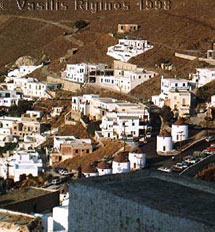
I got back on Thetis around 9:45. There was no change in the forecast. I decided to leave tonight for Lipsi before the weather deteriorated and to enjoy myself in a solo night in the moonlit sea. By the time the zodiac was safely lashed, the sail cover removed, etc. it was close to 11:00 PM. I raised the anchor and we were off at 2250.
During the first 6 miles to Cape Exopetro we had a very gusty wind from the WNW averaging 25 knots. I always want to be on the conservative side when sailing at night so, just in case, I reefed the main to the first reef, well before reaching the cape. The sail, mostly downwind, was very pleasant, but, had I not had the radar to give me accurate distances, I would have been a nervous wreck, because all the little islands as they were silhouetted by the moon loomed deceptively closer then they really were. I have noticed this many times, that at nights I always underestimate distances. The radar reassured me that we were sailing with a very comfortable margin. This was also confirmed by the GPS, but one should not rely exclusively on the GPS because of the charting errors and the random error introduced by the US Navy.
As we were approaching Cape Exopetro, I installed the spray hood anticipating that we might have to sail όρτσα (ortsa - beating against the wind) and have some spray. After rounding the cape and sailing north for a few miles the wind diminished to 15-20 knots and veered NW. It was a most comfortable sail at 4.5-5 knots, while still keeping the reef, without straining the boat. No spray!
During the night, we passed two large ships within 2 miles, again the radar was instrumental in helping me keep the closest approach no closer than this. The moonlight was glorious in the open sea. I was exuberant feeling the boat glide silently on the silver sea. It seems that having survived a heart attack makes one even more appreciative of such precious moments. It is indeed hard to imagine a better life than this.
Friday August 7, 1998 Day 6
Shortly after the large orange orb of the moon set, the new day started breaking. By that time we were near Leros and 10 miles off Lipsi. With the new day, the wind strength increased and it changed direction, now coming directly at our nose from the N. This was the end of the nice sail, and we had to motor, with mild banging, the rest of the way. We arrived at the Papandria [37° 16.8' N 26° 46.2' E] or Lera cove (because of the little island named Lera at its entrance) of the island of Lipsi at 0940 after 47.3 M.
Lipsi (Λειψοί) is a small but neat island. Its town is very attractive and well kept. It seems that many of today’s inhabitants had at one time emmigrated to Australia and have now returned. They brought with them a certain amount of affluence and a more cosmopolitan outlook than one would expect on such a small island. The Papandria cove is on the southern side of the island which is not inhabited. It is a wonderful cove, well protected from the meltemi (seasonal northerly wind) and has very clear emerald-green waters with a sandy bottom. A few bathers come during the day and there are one or two tents with overnight campers. It is a favorite anchorage of many yachts as there are two other coves near by.
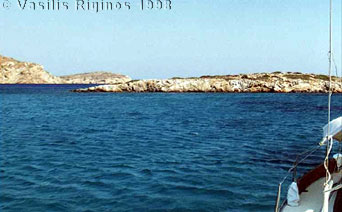 I anchored at 6 m depth and let out over 45 m of chain. While the
water was calm, there were fierce gusts coming from the land. I launched
the zodiac, put up the tent, and picked up the boat. I took a quick dip
and checked the anchor. It was well buried into the sand. Next to
Thetis there was a small sailing boat named Younous
flying a German flag and occupied by a young man and an elderly lady.
They waved, and I asked them to please keep an eye, and if Thetis
appeared to be dragging, to let me know, because I was tired from an
overnight passage and was going to sleep. They assured me not to worry,
and I indeed fell asleep for a few hours.
I anchored at 6 m depth and let out over 45 m of chain. While the
water was calm, there were fierce gusts coming from the land. I launched
the zodiac, put up the tent, and picked up the boat. I took a quick dip
and checked the anchor. It was well buried into the sand. Next to
Thetis there was a small sailing boat named Younous
flying a German flag and occupied by a young man and an elderly lady.
They waved, and I asked them to please keep an eye, and if Thetis
appeared to be dragging, to let me know, because I was tired from an
overnight passage and was going to sleep. They assured me not to worry,
and I indeed fell asleep for a few hours.
After I got up and returned from a refreshing swim, the young man from Younous came over and introduced himself. He is Ali and his parents are Turkish but he is living in Germany. He spends a few weeks every summer cruising with his mother on his boat whose name means Dolphin. The more I hear of the Turkish language the more I like the way it sounds. Younous, it is so musical! Ali loves to sail, and so does his remarkable mother. They are on their way to Amorgos. We had a drink together and exchanged sailing stories of both Turkish and Greek favorite anchorages. I gave him my address in Samos and do hope to see him again.
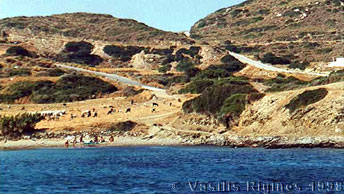 Later, a large herd of sheep descended to the beach from the hills and
mingled with the nudist bathers. Since I felt well rested by then, and
the engine had exceeded 100 hrs of operation since leaving
Glyfada, I occupied myself in the rather unpleasant
task of changing the fuel filters and the oil. I did not have a
replacement oil filter because my spares were badly corroded from the
near sinking that Thetis suffered in the hands of the “experts”
at the Olympic Yachts shipyard.
Later, a large herd of sheep descended to the beach from the hills and
mingled with the nudist bathers. Since I felt well rested by then, and
the engine had exceeded 100 hrs of operation since leaving
Glyfada, I occupied myself in the rather unpleasant
task of changing the fuel filters and the oil. I did not have a
replacement oil filter because my spares were badly corroded from the
near sinking that Thetis suffered in the hands of the “experts”
at the Olympic Yachts shipyard.
After the sun went down, I had an ouzo and cooked dinner. I had a good night’s sleep despite the strong gusts.
Saturday August 8, 1998 Day 7
We left Lipsi at 0845 for Agathonisi. Once we were outside of the cove the wind was much less violent. It was coming from the NNW at 23-30 knots. We had a very nice close haul (όρτσα) sail, with the main in the first reef and the genoa half opened. We arrived at Agathonisi at 1200 (14.25 M). Here again there were strong gusts. The calmest cove was Tsangaris [37° 27' N 26° 58.2' E].
I anchored very close to the shore at 2 m and took two shore lines at the other shore, letting out 35 m of chain and being held at 5 m depth about 12 m from the shore by the lines. I had no difficulty executing these maneuvers, it just took some time but I was in no rush.
After securing Thetis, I put up the tent, had lunch and a long swim. I spent the early afternoon hours pleasantly reading under the tent. A Greek sailing yacht came and anchored near by. She had a large group of very vocal Greeks with many very active children. The men went snorkeling. One came near Thetis and talked to me. They came from Athens and chartered the boat in Patmos. They do not know this area very well and he was asking me lots of information about places to see, good anchorages, etc. It is good to see sailing Greeks! After he left, he swam near his boat and relayed to his mates, in a loud voice, all the information I gave him referring to me as “the young man with the sailboat!” As a 56 year old, I was very flattered.
Since I was not very satisfied with the output of the watermaker, I cleaned it again with both alkaline and acid solutions. While I was so engaged, a small fishing boat came, manned by Yiannis Karides, the cousin of the man I had met in Catholiko a few weeks ago. He identified himself and explained that he is the owner of the 1912 Tsernikoperama (a traditional wooden boat) which is now up for sail in Pythagorio. He is asking for 8 million drachmas (about $28.500) and asked me if I knew of any interested buyers.
In the late evening I went with the zodiac to Port St. George, the main harbor, and had a nice dinner of very fresh grilled fish at the Glaros restaurant.
Back on Thetis, I lay down in the cockpit and waited for the full moon to emerge from over the hill. It was a glorious sight, a full globe which instantly illuminated the whole bay. Everything was transformed to a magic fairyland. I could not resist, I took off all my clothes and jumped into the sea. The water was translucent with the moonlight penetrating at some depth. Also, when agitated, the water sparkled with bio-luminescence still visible in the moon shadows. I had not swam in the full moon for ages, it is good for one’s soul do so once in a while. After I dried and put on warm clothes, I laid on the foredeck and reflected on the magic of the sea. How beautiful she is, how peaceful, and how frightening she can also be, often at the very same time. Tired but very content with the boat, myself, and the world, I went to bed.
Sunday August 9, 1998 Day 8
After the necessary morning coffee, I started picking up the boat, getting ready to transfer back to life on land. Then I did a very foolish thing which I am at a loss to explain. I untied the first cavos (shore line), coiled it, and stowed it. Then I took on-board the outboard and the single oar while Thetis was held in place by the second cavos. Since this cavos (20 m) was almost all used, I tied an extra line to extend it. The idea was that I will leave it slack, and while Thetis was drifting away I would pull myself on the zodiac ashore, untie the cavos, and pull myself and the zodiac back to Thetis. I must have tied a terrible knot, because when the time came to pull myself back on Thetis I found that I was holding a totally loose rope while Thetis was slowly drifting away toward the rocks on the other side of the inlet. I quickly took off my clothes, dove and towed the zodiac by its painter back to Thetis. After this forced early morning swim, caused by my inexcusable carelessness, I collected the zodiac, raised the anchor and departed Agathonisi at 0840.
The wind was strong at 28-32 knots coming from the N, dead against our course for Pythagorio. No chance at all for sailing. We motored for over 4 hours in a miserable beat against the wind and the waves. Thetis was banging on the steep seas, the spray was covering her while I, behind the spray hood, could barely keep an eye for traffic. Again, thank goodness for the autopilot that steered the boat out in the wet and for the radar that let me look for traffic much better than my eyes were capable through the spray. The right main cabin window started leaking like a sieve. I arranged all the sponges and wetexes we had to absorb the water. Water started oozing out of the rear cabin floor soaking the rug. It was miserable! This is the sea for you, beautiful and miserable.
We arrived at Pythagorio [37° 41.4' N 26° 56.6' E] at 1230 almost four hours for a mere 18.4 M. There were a few available spots in the inner harbor. So while Thetis was drifting in the outer harbor I prepared for docking, fenders on both sides, docking lines, and I installed the second windlass control in the cockpit. During these preparations, I was very fortunate to notice that the chain, with all this banging and tossing, had been fouled. So I pulled the chain out of the chain locker, untangled it, and put it back again. With the anchor now ready to drop, we motored into the inner harbor. I made our approach to the chosen spot, turned, put the engine in neutral, secured the tiller on the autopilot, and while Thetis was slowly drifting forward, I went to the bow. When the headway came to a stop, I dropped the anchor and quickly went back to the cockpit and reversed. Then back to the bow to let out chain as she drifted in reverse. Once again in the cockpit to guide her in reverse into the slot while letting out chain via the secondary control. The wind was strong and at our side so everything had to be done at high enough speed to keep positive control of the boat. Into the slot we went. I passed a line to the Italian on the adjacent boat, stopped the motion with a short burst of the engine in forward, jumped ashore with the second line and tied both lines. Not bad for a singlehandled windy docking! We were safe.
It took some time in the midday heat of the harbor to install the passarella, remove the spray hood, cover the sails, cover the outboard etc. I spoke to Mr. Hugo, an Austrian, who together with his wife are in charge of several chartered boats of the Seafearer company. They live and operate out of their motor-sailer which is docked in the inner harbor. They are always there. I gave Mr. Hugo my telephone number in Kalami and he graciously agreed to keep an eye on Thetis and give me a call if something is amiss.
By 2:30 I was on the motor scooter on my way to Kalami and to another world, the world of the land people.
